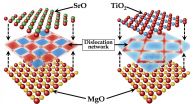(Press-News.org) A new study led by the University of Colorado Boulder found that different strategies used by states to reduce power plant emissions -- direct ones such as emission caps and indirect ones like encouraging renewable energy -- are both effective. The study is the first analysis of its kind.
The findings are important because the success of the Environmental Protection Agency's proposed Clean Power Plan depends on the effectiveness of states' policies in reducing power plants' carbon dioxide emissions. The plan would require each state to cut CO2 pollution from power plants by 30 percent from their 2005 levels by 2030.
"In addition to suggesting that the EPA's Clean Power Plan can work, our results have important implications for the U.N. Climate Summit," said Professor Don Grant, chair of the CU-Boulder sociology department and lead author of the study. "They indicate that while the world's nations have struggled to agree on how to reduce emissions, sub-national governments have been developing several effective mitigation measures. Leaders at the United Nations, therefore, would be wise to shift from a top-down strategy that focuses on forging international treaties to a more bottom-up approach that builds upon established policy successes."
The study was published online this week in Nature Climate Change. The study was co-authored by Kelly Bergstrand of the University of Arizona and Katrina Running of Idaho State University, and was funded by the National Science Foundation.
Researchers had previously found it difficult to determine which state policies, if any, reduced power plants' CO2 emissions because plant-specific data were largely unavailable, Grant said. That changed when the EPA began requiring plants to submit CO2 pollution information as part of its Greenhouse Gas Reporting Program.
Some states have policies that directly limit power plants' carbon emissions and others have addressed carbon emissions indirectly by encouraging energy efficiency and renewable energy.
The study used 2005 and 2010 data to examine the impacts of strategies that are explicitly climate-focused such as carbon emission caps, greenhouse gas reduction goals, climate action plans (comprehensive strategies for reducing a state's carbon emissions) and greenhouse gas registry/reporting system that require plants to register and record their emissions and emissions reductions.
Likewise, the researchers examined indirect policies with climate implications such as efficiency targets, renewable portfolio standards that require utilities to deliver a certain amount of electricity from renewable or alternative energy sources, public benefit funds that provide financial assistance for energy efficiency and renewable energy, and "electric decoupling" that eases the pressure on utilities to sell as much energy as possible by eliminating the relationship between revenues and sales volume.
The study found that emission caps, greenhouse gas targets, efficiency targets, public benefit funds and electric decoupling were the most effective policies for reducing power plants' carbon emissions.
The authors noted limitations of the study, including changes that may have occurred since 2010, that variations within individual policies were not examined and that the most effective policy combinations are not known.
"These limitations notwithstanding, our findings are encouraging news about the efficacy of states' policies," the authors wrote. "The fact that some have decreased individual power plants' emissions after controlling for several other possible determinants highlights their potential as regulatory tools and suggests that states are capable of achieving the emission goals set by the federal government."
INFORMATION:
Grant also is affiliated with the Renewable and Sustainable Energy Institute, a joint venture with the U.S. Department of Energy's National Renewable Energy Laboratory, and the university's Institute of Behavioral Science.
State policies are effective in reducing power plant emissions, CU-led study finds
2014-09-23
ELSE PRESS RELEASES FROM THIS DATE:
Big changes in the Sargasso Sea
2014-09-23
Over one thousand miles wide and three thousand miles long, the Sargasso Sea occupies almost two thirds of the North Atlantic Ocean. Within the sea, circling ocean currents accumulate mats of Sargassum seaweed that shelter a surprising variety of fishes, snails, crabs, and other small animals. A recent paper by MBARI researcher Crissy Huffard and others shows that in 2011 and 2012 this animal community was much less diverse than it was in the early 1970s, when the last detailed studies were completed in this region.
This study was based on field research led by MBARI ...
Study finds gallbladder surgery can wait
2014-09-23
LOS ANGELES – (September 23, 2014) –Laparoscopic cholecystectomy, a minimally invasive procedure to remove the gallbladder, is one of the most common abdominal surgeries in the U.S. Yet medical centers around the country vary in their approaches to the procedure with some moving patients quickly into surgery while others wait.
In a study published online Monday in the American Journal of Surgery, researchers found gallbladder removal surgery can wait until regular working hours rather than rushing the patients into the operating room at night.
"The urgency of removing ...
'Bendy' LEDs
2014-09-23
VIDEO:
This is an animation of the micro-rod growth process.
Click here for more information.
WASHINGTON D.C., Sept. 23, 2014 -- "Bendy" light-emitting diode (LED) displays and solar cells crafted with inorganic compound semiconductor micro-rods are moving one step closer to reality, thanks to graphene and the work of a team of researchers in Korea.
Currently, most flexible electronics and optoelectronics devices are fabricated using organic materials. But inorganic compound ...
Diabetes: Complexity lost
2014-09-23
WASHINGTON, D.C., September 23, 2014 -- For millions of people in the United States living with Type 1 or Type 2 diabetes, measuring the daily rise and fall of blood glucose (sugar) is a way of life.
Our body's energy is primarily governed by glucose in the blood, and blood sugar itself is exquisitely controlled by a complicated set of network interactions involving cells, tissues, organs and hormones that have evolved to keep the glucose on a relatively even keel, pumping it up when it falls too low or knocking it down when it goes too high. This natural dynamical balance ...
Future flexible electronics based on carbon nanotubes
2014-09-23
WASHINGTON, D.C., September 23, 2014—Researchers from the University of Texas at Austin and Northwestern University have demonstrated a new method to improve the reliability and performance of transistors and circuits based on carbon nanotubes (CNT), a semiconductor material that has long been considered by scientists as one of the most promising successors to silicon for smaller, faster and cheaper electronic devices. The result appears in a new paper published in the journal Applied Physics Letters, from AIP Publishing.
In the paper, researchers examined the effect ...
Lack of sleep increases risk of failure in school
2014-09-23
A new Swedish study shows that adolescents who suffer from sleep disturbance or habitual short sleep duration are less likely to succeed academically compared to those who enjoy a good night's sleep. The results have recently been published in the journal Sleep Medicine.
In a new study involving more than 20,000 adolescents aged between 12 and 19 from Uppsala County, researchers from Uppsala University demonstrate that reports of sleep disturbance and habitual short sleep duration (less than 7 hours per day) increased the risk of failure in school.
The study was led ...
Moving to the 'burbs is bad for business
2014-09-23
This news release is available in French. Montreal, September 23, 2014 — It's rare to see a Wal-Mart downtown. Big box stores usually set up shop in the suburbs, where rent is cheap and the consumer base is growing. So should smaller stores follow suit?
Not so fast, says Concordia University professor Tieshan Li. His recent study, published in the Canadian Journal of Administrative Sciences, shows that higher profits are had by retailers located furthest from where the market is expanding.
"Those results may seem counterintuitive but the decreased profits are ...
Los Alamos researchers uncover properties in nanocomposite oxide ceramics for reactor fuel
2014-09-23
Nanocomposite oxide ceramics have potential uses as ferroelectrics, fast ion conductors, and nuclear fuels and for storing nuclear waste, generating a great deal of scientific interest on the structure, properties, and applications of these blended materials.
"The interfaces separating the different crystalline regions determine the transport, electrical, and radiation properties of the material as a whole," said Pratik Dholabhai, principal Los Alamos National Laboratory researcher on the project. "It is in the chemical makeup of these interfaces where we can improve ...
Beating stress outdoors? Nature group walks may improve mental health
2014-09-23
ANN ARBOR, Mich. — They are common suggestions to remedy stress: You just need a breath of fresh air. Walk it off. Get out and see people.
Turns out all those things combined may in fact make you feel better – a lot better – a new large scale study suggests.
Group nature walks are linked with significantly lower depression, less perceived stress and enhanced mental health and well-being, according to the study conducted by the University of Michigan, with partners from De Montfort University, James Hutton Institute, and Edge Hill University in the United Kingdom. The ...
Paraffins to cut energy consumption in homes
2014-09-23
Thermal energy storage is a common strategy in energy production systems in which the period of production does not coincide with that of consumption. This happens with the production of hot water by means of solar thermal panels, for example; here, hot water is produced during sunlight hours when demand is lower. It is also the case in residential cogeneration, where heat and electrical power are simultaneously generated but not so demand. In both cases, storing the heat allows production to be decoupled from demand, thus making the integration of these technologies into ...






